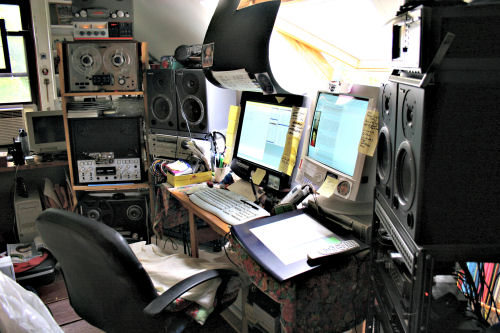A 365-Day Project
"We Are All Mozart"
A project to create
new works and change
the perception of the
music of our time.


 August 22, 2006
August 22, 2006 
Thanks to everyone for the kind mail about yesterday's funny music bits. We're still not funny, but you do what you can, no?
* * *
Some years ago when living in Amsterdam, I was hunting for something unusual. The specifics have fallen out of memory, but following a mumbled but overheard "can you even get this here?" came the response from my stepdaughter's young friend, "You can buy anything in Holland." I've never forgotten the concept of buying anything. Mention Amsterdam and one thinks of the low-key commerce in drugs, but once the Dutch abetted the American slavery establishment. Amsterdam was the historic center of the trade, with the Dutch West India Company reputed to have become the largest slave trader in history.
The slave trade comes increasingly to mind during discussions of intellectual property. Whoa, you're thinking, that's a stretch. Certainly it is today in the early Twenty-First Century, but the concept of unrestricted property can have sinister implications -- and composers are participants in it. There's a vast territory from a self-sustaining individual far from the crowd through the employee and the indentured servant to the abject slave, and the path from independence to slavery can be attractively blazed, just as the path from personal freedom to state control can be paved through appeals to safety and security. Certainly anyone with time and will to reflect is discomfited by the daily compromises of living on the revolving earth. The very ordinariness of co-option is the danger.
Composers have, through their licensing agencies, been led down the path of trading in intellectual property -- not such a bad thing, as some of us depend dearly on the royalties harvested with the fruits of our mental vineyards. Yet the concept of intellectual property is a curious one. This intangible, not a thing, but a thought made manifest in symbols, grows large as the cost of distribution falls. The physical product is ultimately a trifle. A heap of bound paper, some wires & plastic with a smiley face, a shiny polypropylene disc, a throwaway foam container, a machine that rolls us to a destination, a bottle of anonymous white pills -- all trivial, all disposable. You can buy anything.
As products shrink into the virtual, barriers to reproduction fall away. The effort before production becomes paramount, but not entirely in the simple sense of "I thought of it so it's mine." There is sponsored thought, where the idea is produced only through the good graces and economic prowess of others, individual or corporate. There is corporatized thought -- the individual or team creation that is wholly owned by a company, part of the bargain the workers strike to earn a living. There is educational corporatized thought, which is essentially the same bargain save for the fact that the products of thought go to the corporations in exchange for sponsored research facilities. If these were the effective beginnings and endings of the intellectual property range, the protections and compromises would be visible, evaluable, and malleable -- if at times vague.
But it is not the alpha and omega. All thought rises from a shared culture, and what we synthesize as original is a mere contribution returned to that culture. That is the commons often described in intellectual property literature. To understand that is to grasp that the protection of intellectual property is a cooperative artifice, a way of encouraging creativity by rewarding those who have the ability to distill or synthesize apparent nutrition from thin cultural soup -- to draw freely from the commons with the knowledge that return is ultimately anticipated.
This concept has become distorted in several dimensions. The first and most obvious is that the return period has been delayed enormously, stretching from seven years to ninety, and being transformed into something with all the characteristics of tangible property save for physical substance: it can be bought, sold, leased, willed, inherited, and remedies pursued with legal force, extra-legal intimidation, or the technological equivalent of razor wire. The idea of returning these inventions to the commons has been pushed aside as a concept whose time has passed, in particular by the corporatization of intellectual assets, wherein the simpleminded accountancy of investment and return ignores the shared path to creation.
The second distortion is the more serious. There are areas which are fundamental to human existence, such as food, medicine, and human biology. Aside from the hypothetical grey goo scenario, the engineering of food, biology and medicine spite the concept of commons. Not only food but also -- and more importantly -- its seeds and their genetic content are now protected property. And as if the law itself were insufficient, engineering barren hybrids unable to reproduce is a typical extra-legal protection. Seed collection (dubbed "seed hoarding" by corporations such as Monsanto) is disallowed by the purchase contract, and at the same time farmers become responsible for all the side effects of cross-pollination -- including the neutering of neighboring farmers' fields and the pollution of the biological heritage of our human nutrition. The heritage of food production, once spanning family generations, is broken. The reduction of diversity in fruits and grains and vegetables lays them open to widespread disease, not to mention the loss of choice itself. Where a spotted owl might be declared endangered, the passive extermination of the Grimes golden species of apple can pass unnoticed, until blight courses through the genetically weakened food supply. The commons of food becomes shrunken.
Medicine is not entirely the purview of laboratory discovery. Increasingly, traditional remedies are hunted down like prey, extracted and patented. The commons of herbal medicine is raided, and its very practitioners find themselves required to purchase back their own heritage. Roll in the next step -- human biology -- and take note that the human genome, piece by piece, can be protected as the intellectual property of the person who decodes and manifests the patterns in print. Pieces of you and me belong to others.
In a fabled episode of Star Trek, captain Jean-Luc Picard is called upon to defend the android Data against his transport and dismantling by a scientist obsessed by the secrets of what Dr. Noonien Soong had wrought in this android. What could be learned? What better androids could be built? We are not so far from Picard's dilemma as when that television episode, The Measure of a Man, was first broadcast on a February evening seventeen years ago. Were Data to be declared solely a machine and a subsequent race of android replicants be made from Data, they would be slaves.
No, we are not so far from this. We will shortly have the means in food, medicine and biological repair and replication. Simultaneously, we have adopted the attitude of guarding intellectual property as a right against both humanity's history and humanity's commons. If indeed you can buy anything -- not just in Amsterdam, but everywhere -- our march of locking the manifestation of the mind leads us across the wide beach into ethically bloody waters.
Why does this apparently rhetorical question apply to composers? First, because our forebears centuries past were among those responsible for the development and refinement of intellectual property concepts, and our agencies have in more recent times been among the first and most rapacious in the legal enforcement of intellectual property laws, crushing children and old people and even reason itself along the way. The deal we have made as artists has been to cast ourselves in with the lot of the indiscriminately vindictive. And even setting aside the history, we are individuals who, should we stand by as farmers are the first broken on the rack of intellectual property, leave behind our own claim to uniqueness. What offers the illusion of hardened protection is a door locked from both sides, and already the world of nonpop suffers from the inability to use what is part of our commons. Not only copyrights and patents but also the industry-strung razor wire known as digital rights management secure the present and the future from cultural synthesis. Ultimately, the powerful forces, polar opposites and mutual symbiotes -- greed and creativity -- face each other in a stadium of cultural challenge.

How much intellectual property do I create? How much do I use? Can I see the commons in this space? Some of it? Or only it, as the studio walls squeeze in tightly?